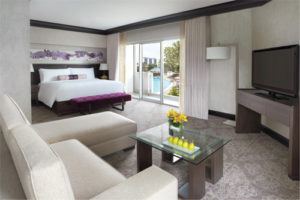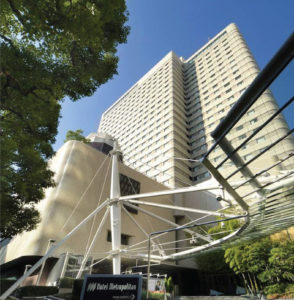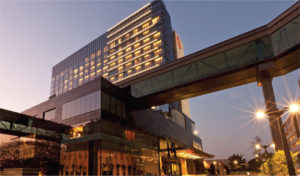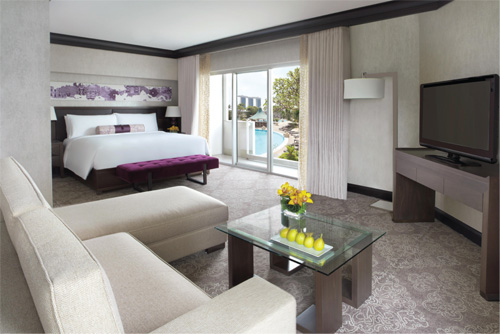TTG Asia‘s probe into mid- and upscale hotel labels uncovers flaws with a seemingly arbitrary classification system – and why travel agents want the muddle taken out of such ratings

SINGAPORE
By Paige Lee Pei Qi
Judy Lum, group vice president for sales and marketing, Tour East Group
Definition of mid- and upscale hotels in terms of prices and brands
• Midscale: S$200 (US$145.70)-S$250; Orchard Hotel, Hotel Rendezvous and Swissotel Merchant Court.
• Upscale: S$300-S$400; Grand Hyatt, Pan Pacific Singapore and Fairmont Singapore.
Current demand Companies undergoing corporate cut backs tend to move from upscale to midscale hotels, which will be seen as a prudent move while (retaining) a presentable image for the company.
C-level executives are (downgrading) from suites in signature and iconic hotels to upscale hotels, which still have strong branding but do not cost an arm and a leg.
Current supply We have good supply of hotels overall but it does not hurt to have more. Singapore is a top destination for business and MICE events so rooms will be filled. A bigger supply will not exert downward pressure but will stabilise rates and make the destination more attractive.
Areas for improvement There’s an increasing number of hotels changing their check-in to 14.00 or even 15.00 and check-out to 11.00. It used to be 12.00 for both check-in and -outs.
Clarification or confusion? In Singapore, I feel that the mid- and upscale labels are being used by some hotels to blindsight the industry and consumers alike to accept a certain price point when their hotel cannot meet the desired star-rating criteria. Hence, it is best to use star ratings or associate the standard or category with a known brand.
Michael Chong, manager of global business, Star Holiday Mart
Definition of mid- and upscale hotels in terms of prices and brands
• Midscale: S$120-S$160; applies to boutique hotels in general.
• Upscale: S$180-S$300, for four stars and above rated hotels.
Current demand There’s a stronger demand for newer hotels. Price and location are the main deciding factors for both categories.
Current supply More midscale hotels are entering the market and the category seems to be oversupplied. With lesser new supply and stiff competition, upscale hotels are lowering rates to a similar level as midscale hotels.
Areas for improvement There should be clearer definitions of category and facilities, and rate stability.
Clarification or confusion? The differentiation line is very thin and blurred, as different hotels have varying classifications. Hotels should work on clearer updates and differentiation factors.
THAILAND
By Xinyi Liang-Pholsena
Victor Mogilev, general manager, Diethelm Travel Thailand
Definition of mid- and upscale hotels in terms of prices and brands
• Midscale: 4,000 baht (US$112.30)-7,000 baht; Amari, Centara and Avani.
• Upscale: 7,000 baht and above; Banyan Tree, Aman Group and Six Senses.
Current demand With the current uncertain world economy, more people
are looking to spend (more wisely) while still wanting personalised services. There is hence a higher demand for midscale hotels, which also see opportunities to attract new clientele beyond their usual segments.
Current supply We expect further development of midscale properties with a focus on quality, personalisation and efficiency, while upscale properties will have to work to retain occupancy and rates.
Areas for improvement Midscale hotels should look into delivering personalised service and consistent standards for both guests and industry partners.
Upscale hotels should make sure products and services are on the bespoke level as guests paying top money have become more demanding than ever.
Clarification or confusion? The main issue is the difference in individual perceptions. For some guests and markets, a room priced at 4,000 baht per night is considered an upscale product while for others even a room at 8,000 baht will be taken as an average product.
Kim Martin Rasmussen, product manager, Exo Travel Thailand
Definition of mid- and upscale hotels in terms of prices and brands We rely on star ratings and our hotel classification system instead of these terms.
Current demand Midscale hotels are emerging for new growth markets where price is still a factor for travel to Thailand; these hotels are also widely used in our SIC programmes. We always have a demand for upscale hotels due to (our predominantly high-end clientele).
Current supply Small boutique hotels in the midscale category can be in shortage during peak seasons, so more boutique midscale hotels would be nice. Upscale hotels appear to be in demand year-round and run out of supply during peak seasons.
Areas for improvement More boutique hotels and better service in the midscale range would be good in key destinations. Upscale hotels can benefit from more options and inventory, clear separation of rates for agents and direct clients, and extra benefits when booked through agents.
Clarification or confusion? We do not use these terms. The confusion comes more from boutique vs luxury distinctions.
MALAYSIA
By S Puvaneswary
Manfred Kurz, managing director, Diethelm Travel Malaysia
Definition of mid- and upscale hotels in terms of prices and brands
• Midscale: RM400 (US$103)-RM500 in Kuala Lumpur and RM500-RM800 in Langkawi and Sabah; Four Points by Sheraton, Dorsett and Holiday Villa.
• Upscale: RM600 and above in Kuala Lumpur, and RM800 and above in Langkawi and Sabah; for St Regis, Mandarin Oriental and Grand Hyatt.
Current demand The favourable exchange rate has contributed to demand. As well, demand for beach hotels is higher during the Malaysia and Singapore school holidays. City hotels do well on weekdays because of corporate and meetings demand.
Current supply Kuala Lumpur has an oversupply of mid- and upscale hotels. In Sabah, there is an undersupply during the May-October peak season. In Langkawi, the supply is just right.
Areas for improvement Service levels must be improved on for both categories.
Clarification or confusion? A midscale five-star property could operate like a four-star brand, so guests’ expectations are not (always) met.
Ally Bhoonee, executive director, World Avenues
Definition of mid- and upscale hotels in terms of prices and brands
• Midscale: US$70-US$80; four-star hotels like Holiday Inn, Furama and Melia.
• Upscale: US$110-US$250; five-star hotels like Westin, JW Marriott and Ritz-Carlton.
Current demand There is greater demand for upscale hotels due to the
ringgit depreciation, which makes upscale hotels good value for money as it
costs a third of a similar brand in Europe.
Current supply There’s an oversupply in the capital city right now and Kuala Lumpur City Hall has temporarily stopped issuing new licenses for all hotel types. In secondary destinations such as Penang, Johor and Kuching, there is room for more investments in upscale hotels.
Areas for improvement I would like for hotels to improve service and for owners to upkeep their properties.
Clarification or confusion? Some define midscale as a four-star and upscale as a five-star property, while others refer to a five-star deluxe hotel as midscale and a five-star super deluxe hotel as an upscale one. Such (varying) definitions are confusing to travellers who tend to recognise hotels by their brands and star ratings only.

JAPAN
By Julian Ryall
Tetsuya Takeda, general manager of inbound division, Nippon Travel Agency
Definition of mid- and upscale hotels in terms of prices and brands
• Midscale: The Keio Plaza, The Royal Park and The Shinagawa Prince.
• Upscale: The Mandarin Oriental, The Ritz-Carlton and The Peninsula.
For an agent, it is too sensitive for us to put a price on hotel rooms.
Current demand We are seeing demand for midscale properties because they tend to cater to larger groups of foreign tourists, while luxury hotels are more geared towards VIP travellers. Demand is extremely high now and continues to rise (with the surge in foreign tourists to Japan).
Current supply Japan has a room shortage and the situation particularly acute in Tokyo, Osaka and Kyoto. It does not seem feasible that new hotels can be built fast enough for Japan to accommodate 40 million visitors for the 2020 Olympics. We are trying to alleviate the problem by encouraging visitors to stay outside the big cities or come at different times of the year.
Areas for improvement Besides a bigger room supply, we need to ensure that new properties have adequate parking spaces for tour buses. Many city-centre hotels do not and guests often need to walk some distance to their hotel. The government should give out tax breaks for hotels that include parking facilities.
Clarification or confusion? Tour groups usually follow the advice of their agents when it comes to hotels, but there may be some confusion among independent travellers. American tourists, for example, generally want bigger rooms but Europeans are more focused on the hotel location, so the demands and expectations of what is upscale or midscale are different.
Hiroyasu Shima, director of sales, Triangle Japan
Definition of mid- and upscale hotels in terms of prices and brands
• Midscale: from US$300; Hotel Metropolitan Tokyo Ikebukuro, The Tokyo Dome Hotel and The Shinagawa Prince.
• Upscale: US$700 and above; The Shangri-La Hotel, The Conrad and The Peninsula.
Current demand There is huge demand for hotel rooms across all price brackets in the major cities. Agents are now bringing a lot of tourists from South-east
Asia, and they are filling up the midscale hotels.
Current supply Five years ago, it was easy to get rooms pretty much any time of the year as most visitors tended to be wealthy and stayed at five-star hotels. Now we are facing a shortage of rooms across all price brackets and the consequent price increase gets passed on to the customer.
Areas for improvement The average Japanese hotel (used to) focus on the needs of domestic travellers because only around 10 per cent of guests were from overseas. That figure is now above 30 per cent in most places but most operators have not added new services or facilities such as providing halal meals. We have to go beyond building new hotels to meet demand.
Clarification or confusion? There is some confusion among foreign visitors, primarily over price and service levels. Prices are rising due to the room shortage and travellers from other parts of Asia are surprised at the amount they have to pay for seemingly basic rooms and services.
HONG KONG
By Prudence Lui
Jenny May, managing director, The Destination Management Company
Definition of mid- and upscale hotels in terms of prices and brands
• Midscale: HK$1,500 (US$193.22)-HK$2,350; Sheraton, Marco Polo and Hyatt Regency
• Upscale: HK$2,400-HK$3,400; Shangri-La, Grand Hyatt and InterContinental.
Current demand Despite the current downturn in tourism, demand for both categories is still quite high. With most hotels now offering special rates, it’s possible to book an upscale hotel at midscale rates, which is beneficial for MICE agents as clients can reduce their hotel costs and spend more on ground programmes.
Current supply There is enough midscale hotels but the city could do with a few more upscale hotels – a few brands have not entered into Hong Kong yet. It amuses me that a few lower-scale hotels are classifying themselves as midscale and trying to charge midscale rates even during this dire tourism season.
Areas for improvement Standards in Hong Kong are already exceptional.
Clarification or confusion? These terms are ambiguous and confusing. The star-rating system is much better.
Ivy Sung, CEO, Faces of Hong Kong
Definition of mid- and upscale hotels in terms of prices and brands
• Midscale: HK$1200-HK$1300; W, Sheraton and New World Millennium Hong Kong.
• Upscale: HK$2000-HK$3000; The Peninsula, Four Seasons and Shangri-La.
Current demand (Looking at corporate travel trends), industries like pharmaceuticals are opting for midscale over upscale accommodation (as they are limited by) their compliance policies amid existing economic conditions.
Current supply The supply seems enough for both categories unless inbound traffic, especially from China, recovers.
Areas for improvement Service standards have dropped (relative to) other Asian cities. The immediate cause is higher labour cost and manpower shortage. Greater work pressure also leaves staff less time to mingle and interact with customers.
Clarification or confusion? Some five-star hotels are beyond five-star standards so the grading cannot reflect the reality. Also, some suppliers are not clear on the difference between four- and five-star premises.
CHINA
By Caroline Boey
Sam Lay, director, Greater China, BCD Meetings & Events
Definition of mid- and upscale hotels in terms of prices and brands
• Midscale: RMB500 (US$77)-RMB1,000; Renaissance, Pullman and Novotel.
• Upscale: RMB1,000-RMB2,500; JW Marriott, Shangri-La and Ritz-Carlton.
Current demand The large domestic market continues to drive demand for all categories. In particular, we are seeing strong demand for midscale hotels, driven by growing corporate meetings especially from a policy compliance perspective.
Current supply For the tier-one cities of Beijing, Shanghai and Guangzhou, there is a good mix already present or in the pipeline for both hotel categories. Supply growth should be focused on tier-two and -three cities cities like Xi’an and Chengdu with good MICE traffic.
Areas for improvement The overall offerings of mid- and upscale hotels are generally satisfactory, but China still has room for improvement in the service touchpoints.
Clarification or confusion? There is a lot of ongoing debate regarding the two terms and definitions. It is key for meeting planners to understand the client’s requirements, and to deliver value by recommending the right hotel.
Violet Wang, destination manager, Pacific World China
Definition of mid- and upscale hotels in terms of prices and brands
• Midscale: RMB1,000-RMB1,600; Langham, Fairmont and Westin.
• Upscale: above RMB1,600; Peninsula, Waldorf Astoria and Banyan Tree.
Current demand There is good demand in both categories in China. The strict compliance policies for the pharmaceutical industry and government events, where accommodation is capped at midscale hotels, is contributing to high demand for mid-range meeting hotels.
Current supply More hotel groups are now debuting their high-end brands into China, as Chinese customers become better educated and seek out luxury brands.
Areas for improvement Midscale hotels should not lower their service levels even if they decide to reduce their rates amid stronger competition. Upscale hotels need to stretch their capabilities to accommodate larger groups for outside catering and offer distinctive programmes such as cultural lectures, specialised cooking classes and Chinese opera.
Clarification or confusion? In some Chinese cities, brands such as Sheraton and Aloft are both considered mid- and upscale. Customers also still depend on the hotel’s star rating to determine if it is mid-scale or upscale.
To a (lay) customer, any five-star hotel is (considered) upscale but our standard is to follow the automative and luxury industry’s definition.

INDIA
By Rohit Kaul
Subhash Goyal, chairman, STIC Travel Group
Definition of mid- and upscale hotels in terms of prices and brands
• Midscale: Rs2,500 (US$37.34)-Rs5,000; Choice Hotels, ibis Hotels and Sarovar Park Hotels.
• Upscale: Rs10,000 and above; Hyatt, Sheraton and Leela.
Current demand There’s strong demand for both categories but most are being diverted to the New Delhi Capital Region (NCR) as there is 15 per cent luxury tax on the published tariff in New Delhi, versus 10 per cent on the actual tariff in NCR.
Current supply New Delhi has a shortage of midscale hotels but an oversupply of upscale hotels after (multiple openings) in Aerocity near the international airport.
Areas for improvement Hotels in both categories need to offer free Wi-Fi and provide the same rates to travel agents and tour operators as given on the Internet.
Clarification or confusion? The difference is clearly understood by the travel agents, tour operators and consumers alike.
Ayappa Somaiah, vice president, Splendour Holidays
Definition of mid- and upscale hotels in terms of prices and brands
• Midscale: Rs3,500-Rs4,000; Quality Inn, ibis and Fortune.
• Upscale: Rs5,000-Rs6,000; Vivanta, Marriott and Sheraton.
Current demand For the average foreign and domestic leisure travellers, midscale is preferred for its rates and value-for-money features. Corporate and high-end leisure travellers prefer upscale hotels for the comfort, facilities and full services.
By and large upscale hotels in major Indian cities are in demand, while in the secondary cities midscale hotels fuel growth.
Current supply Professionally-managed midscale hotels are not evenly distributed. For example, in Bengaluru there are adequate upscale hotels but a shortage of midscale hotels. Currently, we see more upscale hotels entering the big cities.
Areas for improvement Upscale hotels generally conform to international product and service standards but it is not the case for midscale hotels that do not belong to reputed chains.
There is a shortage of well-trained staff across both segments but we, as an inbound tour operator, receive most complaints on midscale hotels.
Clarification or confusion? This confusion is mainly with foreign travellers, as sometimes our upscale hotels do not conform to standards (they are familiar with, due to varying definitions across the world). But this scenario is changing with many international brands now coming up.
SRI LANKA
By Feizal Samath
Nilmin Nanayakkara, managing director, NKAR Travels & Tours
Current demand Current country-wide demand is for the three- and four-star range. Europeans are looking more at the three- or four-star range, probably due to the economic recession, while new markets like China tend to opt for four- and five-star hotels.
Current supply There has been an increase in room supply reflecting the national growth in tourism. However, there is a shortage of three-star hotels if going by the ratings of the hotels themselves.
Areas for improvement It is necessary for the authorities to impose a proper star rating system without allowing the hotels to decide on their own ratings.
Clarification or confusion? Some OTAs allow (arbitrary) star ratings to be attached to hotels. Lots of three-star quality products are sold as four-star ones, diluting the four-star recognition.
Also, some four-star quality products are found in the five-star category due to the minimum rates policy between city hotels. This confuses the end buyer and creates a bad image for the destination.
Anura Lokuhetty, chairman, Asian Council on Tourism
Definition of mid- and upscale hotels in terms of prices and brands Upscale refers to hotels five star and above while midscale tend to be three- to four-star properties.
Current demand There is more demand for the midscale sector, with the industry driven by affordability.
Current supply After the end of the civil war, most old hotels have gotten a facelift while the newer ones are mostly in a higher category. In terms of product (mix) we are on the right track.
Areas for improvement The huge informal sector – which in the past five years has mostly evolved in the mid-to-lower – needs to be regulated.
Pricing is also a sensitive issue and we need to ensure our rates are competitive with other destinations in the region. We need to be careful in accelerating development in order to retain this beauty and authenticity of Sri Lanka.
Clarification or confusion? The NTO has its own star rating system, while most operators have their own classification. We may tag a property five star but some operators will refer it to as three to four stars.
This article was first published in TTG Asia, June 3, 2016 issue, on page 14 To read more, please view our digital edition or click here to subscribe.




















